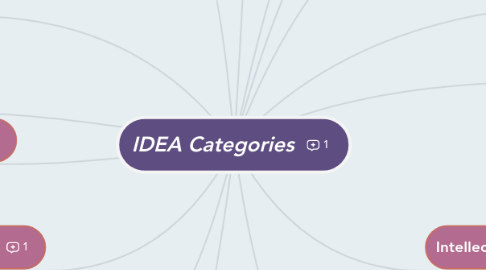
1. Emotional Disturbance
1.1. There are six types of emotional disturbances
1.1.1. Anxiety disorders
1.1.2. Bipolar disorder
1.1.3. Conduct disorders
1.1.4. Eating disorders
1.1.5. Obsessive-compulsive disorder (OCD)
1.1.6. Psychotic disorders
1.2. Educational challenges
1.2.1. Potential classroom disruptions
1.2.2. Inability to maintain relationships with peers and teachers
1.2.3. Inappropriate behavior or feelings
1.3. Strategies adopted
1.3.1. Postive Behavioral Support (PBS)
1.3.2. Collaboration with behavioral therapist and/or psychotherapist
2. Hearing Impairment
2.1. Not included under the definition of "deafness"
2.2. Educational challenges
2.2.1. All educational obstacles stem around communication
2.2.2. Listening to lectures
2.2.3. Watching educational videos
2.2.4. Presenting oral reports
2.2.5. Grammar, spelling and vocabulary subjects
2.3. Strategies adopted
2.3.1. Early intervention is key
2.3.2. Voice and articulation training
2.3.3. Assistive technology
2.3.4. Lip reading
2.3.5. Sign language
2.3.6. Turning on captions while watching a video
2.4. Case study: Hanna
2.4.1. She is in a regular classroom
2.4.2. Teacher always addresses her face to face communication
2.4.3. Accommodation: reading lips
2.4.4. Group projects as part of her treatment
3. Orthopedic Impairment
3.1. Evaluation is required to be classified in this category
3.2. Educational challenges
3.2.1. Non-accessible transportation
3.2.2. Trouble maneuvering around the classroom
3.2.3. Communicating effectively
3.3. Strategies adopted
3.3.1. Classroom arrangments
3.3.2. Communication-based assistive technology
4. Speech or Language Impairment
4.1. Affects child's educational performance
4.2. Covers stuttering, articulation, language and voice impairments
4.3. Educational challenges
4.3.1. Communication skills
4.3.2. Be active in the classroom
4.3.3. Understanding curriculum materials
4.4. Strategies adopted
4.4.1. Early intervention
4.4.2. Use a speech-language pathologist
4.4.3. Address the issue of bullying if occurs
4.4.4. Simple tasks and assignments
5. Traumatic Brain Injury
5.1. Includes mental, physical and emotional disabilities
5.2. Educational challenges
5.2.1. Short and long-term memory difficulties
5.2.2. Problems with following directions
5.2.3. Difficulty learning new skills
5.2.4. Problems concentrating
5.3. Strategies adopted
5.3.1. Allow extra time to complete homework and tests
5.3.2. Break down directions to small steps
5.3.3. Teach students to use a day planner to eliminate confusion
6. Visual Impairment (Including Blindness)
6.1. Includes irregular eye movements, unusual habits and sitting abnormally
6.2. Education challenges
6.2.1. Conceptualizing objects
6.2.2. Classroom setup
6.2.3. Operating standard tools
6.2.4. Reading
6.3. Strategies adopted
6.3.1. Early intervention
6.3.2. Add hearing assistive technology
6.3.3. Sensory learning
7. Other Health Impairment
7.1. Includes AD/HD
7.2. Educational challenges
7.2.1. Safety issues in the classroom
7.2.2. Need of immediate medical attention
7.2.3. Repetitive abscence due to sickness
7.3. Strategies used
7.3.1. Make up classes
7.3.2. Educational plan
8. Sources
8.1. http://www.parentcenterhub.org/repository/categories/
8.2. http://www.parentcenterhub.org/wp-content/uploads/repo_items/gr3.pdf
9. Autism
9.1. Difficulty understanding social interactions
9.2. Educational challenges
9.2.1. Trouble following directions
9.2.2. Hampered ability to communicate
9.2.3. Disinterest
9.2.4. Disruptive behavioral problems
9.3. Strategies used
9.3.1. Assistive technology
9.3.2. Give a simple and direct direction
9.3.3. Follow a routine
9.4. Case study
9.4.1. Main teacher meets with a team to discuss how to minimize the student's anxiety
9.4.2. Student has social, physical, academic and behavioral needs
9.4.3. High anxiety
9.4.4. Student accomodation
9.4.4.1. No pushing
9.4.4.2. Talk to the classroom when he feels comfortable
9.4.4.3. Aid: computer games and math games
10. Deaf-Blindness
10.1. Educational challenges
10.1.1. Understanding classroom lectures
10.1.2. Participating in class discussions
10.1.3. Presenting oral reports
10.1.4. Fulfilling reading assignments
10.2. Strategies adopted
10.2.1. Direct and simple directions
10.2.2. Emphasizing the power of touch
11. Deafness
11.1. No ability to hear intensity (loudness), pitch (frequency) or both
11.2. Educational challenges
11.2.1. Learning by lectures
11.2.2. Note taking
11.2.3. Taking oral exams
11.2.4. Watching educational films
11.2.5. Giving oral presentations
11.3. Strategies adopted
11.3.1. Text-to-speech assistive technology
11.3.2. Assistive listening device
11.4. Case study: Deafness in the classroom
11.4.1. Obstacles: no communication, comprehend speech
11.4.2. Student's accomodations
11.4.2.1. Assisted technology
11.4.2.2. ASL as a first language
11.4.2.3. Uses of auditory-oral , auditory-verbal education
12. Intellectual Disability
12.1. Significantly subaverage general intellectual functioning
12.2. Delay in reaching developmental milestones
12.3. Poor problem-solving skills
12.4. Educational challenges
12.4.1. Trouble understanding new concepts
12.4.2. Inappropriate behavior
12.4.3. Limited vocabulary
12.4.4. Difficulty accomplishing complex tasks
12.5. Strategies adopted
12.5.1. Postive reinforcement
12.5.2. Clear and slow tasks
12.5.3. Repetitive routine
12.5.4. Verbal instruction with visual clues
13. Multiple Disabilities
13.1. Educational challenges
13.1.1. Capability to function in the classroom
13.1.2. Communication skills
13.1.3. Assessing and compensating for visual or hearing impairments
13.2. Strategies adopted
13.2.1. Physical and occupational therapy
13.2.2. Assistive technology
13.2.3. Assigned aid if possible
13.2.4. Sign language, hearing aids
13.2.5. Priority seating
14. Specific Learning Disability
14.1. Includes conditions such as perceptual disabilities, brain injury, minimal brain dysfunction, dyslexia and aphasia
14.2. Educational challenges
14.2.1. Difficulty holding a pencil
14.2.2. Difficulty reading, writing, listening, speaking and reasoning
14.2.3. Trouble understanding lectures
14.2.4. Struggling to write papers and essays
14.3. Strategies adopted
14.3.1. Identify students' weaknesses and strengths
14.3.2. Simple assignments with clear tasks
14.3.3. Provide assistance with homework
15. Developmental Delay
15.1. Affects language or speech, movement, social and emotional skills and thinking
15.2. Educational challenges
15.2.1. Participating in classroom discussions
15.2.2. Communicating effectively
15.3. Strategies used
15.3.1. Set expectations
15.3.2. Provide simple and clear tasks
15.3.3. Provide social classroom experience
